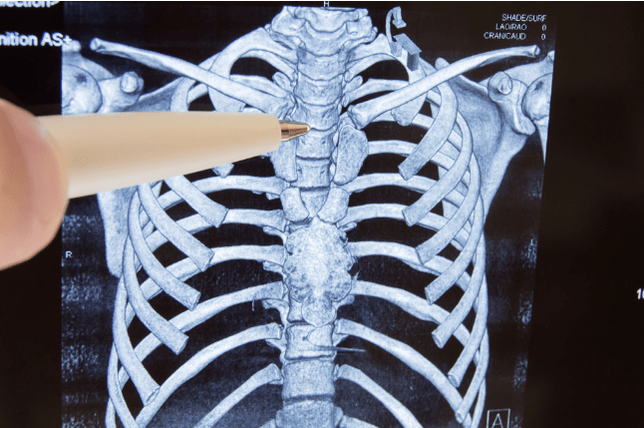Osteochondrosis is a disease of the spine in which the intervertebral discs (and then the body of vertebrae, joints and ligaments) lose their ability for normal functioning.

The cause of osteochondrosis is currently considered a number of factors that affect the back during a person's lifetime.An additional risk of osteochondrosis develops damage to the spinal column as well as the breakdown of behavior.Some patients mark the onset of the onset of the disease and hypothermia.
In practice, it is customary to consider
- cervical osteochondrosis,
- Osteochondrosis of the chest and
- lumbar spine.
Separately, it should be noted that osteochondrosis is common, characterized by damage to some parts of the spine immediately.
The most common is cervical and chest forms, as it is these spinal departments that undergo larger loads.
Symptoms of osteochondrosis
With osteochondrosis, patients prescribe symptoms such as:
- Paroxysmal pain or with shots in the back affected by osteochondrosis;
- increased pain after physical exercise as well as in the morning;
- Pain can be given to the neck, arm or foot, as well as in the chest;
- Feeling stalemate when you turn twist.
Osteochondrosis is also characterized by symptoms of a neurological nature on the affected side:
- partial violations of movement (paresis);
- unpleasant sensations in the form of eggplants, tingling;
- During palpation, the muscle tension corresponding to the affected department is determined.
The disease begins and develops gradually, not severe.
It is necessary to distinguish osteochondrosis of the spine from coronary heart disease (with coronary heart disease, the onset of pain is not associated with physical activity, but is due to the lateral factors: cough, prolonged seat).
Treatment
The same symptoms can be signs of various diseases, and the disease may not occur according to the textbook.Do not try to treat yourself - consult your doctor.
Osteochondrosis therapy always requires an integrated approach.In treatment, the attention of doctors such as therapist, rheumatologist, neuropathologist and physiotherapist is needed.The treatment of osteochondrosis of the spine depends on the localization, the predominant symptoms and the severity of the disease.
Conservative therapy is aimed at eliminating the symptoms of pain as well as restoring the normal function of the spine.
Rational nutrition for osteochondrosis greatly facilitates the patient's condition and promotes more effective therapy.Read more about the food principles for osteochondrosis in our special article.
About 10% of patients are sent for surgical treatment.The absolute indicator of surgical intervention in osteochondrosis is the appearance of neurological disorders due to the pinch of the spinal cord itself.
Additional indicators for surgical treatment of osteochondrosis are considered to be below:
- prolonged periodic pain attacks;
- Increased mobility and suspicion of instability in the back;
- ineffectiveness of medication therapy for 3 months;
- Pronounced disorders that prevent the patient from leading a full life.
Surgical treatment methods
Surgical interventions with minimal trauma:
- Preparations-INJECTIONS-Enzyima Preparations are administered to the intervertebral disc after the purpose of tooth decay and fibrous disk ring.
- Nucleotomy Bear - interrogation of the intervertebral disc for removing a portion of poison.
- Dena denereration - a drug is inserted into the intervertebral disc that blocks the sensitivity of nerve endings.
The remaining methods of surgical treatment of osteochondrosis of the spine are less soft.These include:
- Complete or partial removal of the intervertebral disc or its hernia - this operation is aimed at reducing compression symptoms.
- Prosthetics of the intervertebral discs - the main task is to adjust the affected vertebral segments.
Operational methods for the treatment of spinal osteochondrosis provide a forecast for a complete recovery in just 50% of cases.
With timely treatment, the prognosis for life is almost always favorable, but the prognosis for the ability to work may be different due to a number of factors.
Osteochondrosis exercises
Exercise 1.
Tilt your head forward as you press on the forehead with woven fingers.Press closely the fingers on the back of the head and whiskey - left, right.The head counteracts the pressure of the hands and hands - the head pressure.Spend 10 seconds.for every movement.
Exercise 2.
Put the tips of the four fingers on the forehead against each other, gently press on the skin with the entire surface of the palm and with soft attractive movements extend it for 10-40 seconds.We can make the same stretch in the temple in the longitudinal and transverse direction.The same thing - in the ear - to extend it in all directions, especially the lobby.It improves blood circulation in rich areas with biologically active spots.
Exercise 3.
This type of massage improves blood flow to the jugular veins, and brain nutrition improves.Sit exactly, the back is straight.Slowly get your head back, helping with your hand, pressing the beard back and up.You can slowly turn your head slightly left and right.Stay in this position for about a minute.For children, 10 seconds are enough.
Exercise 4.
This exercise improves the function of the cervical nerve plexus.Sit exactly, the back is straight.Slowly stick your head forward, trying to touch your chest chin.Place the woven fingers on the back of the head, press forward and up, raising the back of the head.Sit down for about a minute.After 15 minutes you can repeat.
Exercise 5.
Raise your shoulders up, trying to get it in your ears, lower, free, faster - for 15 seconds.Now alternately - one shoulder, the other is down, also 15 seconds.Pull the cervical spine with your palms.






















